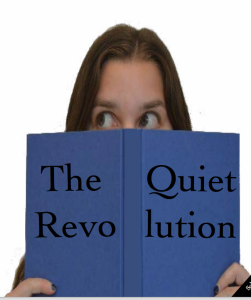Check all that apply:
- You prefer one-on-one conversations to group activities
- You prefer to express yourself in writing
- You enjoy solitude
- You seem to care less about wealth, fame, and status than your peers
- People have told you that you are a good listener
- You are not a big risk-taker
- You enjoy work that allows you to “dive in” with few interruptions
- You like to celebrate birthdays on a small scale, with only one or two close friends and family members
- People describe you as “soft spoken” or “mellow”
- You prefer not to show or discuss your work with others until you are finished
- You tend to think before you speak
- You often let calls go through to voicemail*
*Adapted from Quiet: The Power of Introverts in a World that Can’t Stop Talking by Susan Cain, based on characteristics of introversion commonly accepted by contemporary researchers.
If you checked off a majority of the questions, you are probably an introvert. If you checked off half of the questions, you are probably an ambivert, one who falls in the middle of the introvert-extrovert spectrum. If you checked off less than half of the questions, you are probably an extrovert.
However, no one simply falls into one of these discrete categories. Introverts can be seen at wild parties and extroverts can enjoy curling up with a good book. As Swiss psychologist Carl Jung said, “There is no such thing as a pure extrovert or a pure introvert. Such a man would be in the lunatic asylum.”
But why does all of this matter anyway? Who cares where you fall on the introvert-extrovert spectrum?
Many believe that it is our duty as human beings to be in touch with our personality; introversion or extroversion lies at the heart and soul of human nature. When you make life choices that are congruent with your temperament, you are able to be much more successful and efficient. Conversely, when you spend too much time battling your own nature, the opposite happens – you exhaust yourself and your ability to succeed.
In her book, Quiet: The Power of Introverts in a World that Can’t Stop Talking, Susan Cain revolutionizes the notion that society over-values extroversion as an ideal and is biased against introversion: “A widely held, but rarely articulated, belief in our society is that the ideal self is bold, alpha, [and] gregarious.”
Instead of embracing the benefits of an introvert’s quiet, reflective style, the world we live in encourages everyone to act like extroverts – to be assertive, outgoing, and to love working in teams. This, Cain says, “is a colossal waste of talent, energy, and happiness” for those who do classify as an introvert.
As well as adults in the workplace, students and their working environments have been altered in order to maintain an extroverted learning space. Years ago, a typical classroom layout had all of the desks in rows and columns with each kid working individually. Over the years, classrooms have progressed into many different arrangements including several clusters around the rooms and U-shapes in order to promote constant sharing and working together.
While collaboration is important, there are alternate ways that schools can gear the structure of a class to suit various personality types. It seems as though Schechter has not yet found this balance, as a poll conducted by The Lion’s Roar revealed that 86% of introverts at Schechter feel undervalued at school due to their learning style preference.
Junior Sandy Reisman, who categorizes herself as an introvert, said, “I think a lot of teachers don’t understand me. There are a lot of teachers that think it’s great that I think things through, but then there are those teachers that want me to participate more in class even though I don’t really see a need in it.”
Perhaps teachers are not made aware of the inequality in treatment between introversion and extroversion. Engineering and Entrepreneurship teacher Dr. Daniel Aviv said, “I think there is a lack of understanding that may translate into a bias [against introverts] but it’s just a lack of understanding. I mean I’m a seasoned teacher who went to Education School and it’s not something that’s on our radar, which is crazy if [Cain] is justified in saying her statistics of 30-40% [of people in the world are introverts]. I mean that’s serious.”
At Schechter, Cain’s statistics mentioned by Aviv, seem to run relatively true as 25% of the student body at Schechter self-identified as an extrovert, 45% as an ambivert and 23% as an introvert.
Given that a significant percentage of people identify themselves as introverts, it is important for Schechter to start shifting its mindset and changing the bias.
“I think as we continue to evolve as a school and as an educating body, the idea of trying to monitor what students know rather than the public forum of having to raise their hand and speak in front of a group of kids, may be a really good thing for us to do,” High School Psychologist Dr. Blank said.
Aviv has already attempted to gear his class in a way that is more accessible to introverts. The entire Entrepreneurship and Engineering course is designed around working in teams, leaving little room for the introvert who maybe does not have much to offer when brainstorming in large groups but would come up with great ideas when allowed to come up with ideas by himself or herself and then present it to the group.
In an attempt to appeal to more than one personality type, Aviv recently asked a sophomore class to work individually on critiquing a website’s design. Aviv reported that the experiment was successful, as he received a long list of criticism from everyone who had an opportunity to brainstorm on their own.
However, there are still many strides to be made in terms of introversion bias in schools. Many schools, including Schechter, place an emphasis on extroversion in their grading of participation. By forcing introverts to participate by dangling good grades over their heads, schools are under-appreciating the value of the listening and reflecting that takes place when one is not participating, as well as forcing those who are introverted into an area of major discomfort.
“I am a product of a school system that encourages active participation in a classroom, and we as teachers are often under the impression that if a student is not quote unquote engaged obviously, then that means that they are not engaged and they are not fulfilling their potential,” Aviv said. “[Susan Cain’s Ted Talk on Introversion] gave me a different perspective by saying that there is actually learning occurring and productive thinking occurring in the absence of active participation. It really has or will affect the way I think about classrooms, and what it means to participate.”
Junior Taylor Salomon, who self-identifies as an introvert says, “Literally every single narrative I’ve gotten this year had two or more sentences telling me to speak more in class. They don’t say it in a negative way, they say it positively like ‘I’d like to hear you speak up more in class because I’m sure you have good ideas to share,’ but that’s just what my personality is, and they don’t like that about me and are trying to change it. Each student expresses their knowledge in a different way; judging everyone in the same way will not give everyone the best shot at succeeding.”
In her blog, “Shameless Judaism: Adventures in Spiritual Refinement,” Rabbi Sosland writes, “The ability to be silent is a pretty amazing trait (a tough one for me!). So then we have to ask ourselves: why do we push so many of our students to “participate” more in class? I don’t believe that every student needs to participate in the way that teachers so often say. Every year, parents tear up when I say it’s okay if their child doesn’t speak in class. [They’ll say to me,] ‘For 12 years, teachers have told us that he needs to speak more in class. This is the first time anyone has ever told us that it’s okay for him to be himself.’”
While no one is denying that classroom participation is an important piece of contributing to the learning of your peers, introverts should not have to sacrifice their nature and learning styles for the sake of grades or a teacher’s approval.
“The vast majority of teachers’ reports believe that the ideal student is an extrovert as opposed to an introvert,” Cain said.
The same perception that introverts are inferior students is also projected onto the archetype of leaders: “It has long been believed that the natural leaders of our society were the extroverted types, those that were outspoken, sociable, and decisive,” Forbes contributor Karl Moore said.
A study at the University of North Carolina concluded that 96% of managers and executives display extrovert characteristics.
Even at Schechter, 35% of students reported that they believe extroverts are generally more qualified to be leaders than introverts. Of that percentage, the majority described themselves as extroverted.
Self-proclaimed extrovert junior Jacob Fortinsky said, “I am more qualified to lead a group than is someone who is more quiet. Passive people are indecisive. Introverts are passive. Maybe it’s stereotypical, but it’s probably true that introverts are more quiet, more timid, less competent in general, in terms of leadership but not in terms of the quality of their work. If you think about leaders in any capacity whether it’s Obama or Presrig [Schechter Student Government President Caleb Esrig], it’s someone who is able to inspire others and it’s hard to do that if they are reserved themselves.”
Yet some of the most transformative leaders in history have been introverts: Eleanor Roosevelt, Rosa Parks, Nelson Mandela, and Mahatma Gandhi to name a few. These leaders all described themselves as quiet and soft-spoken. Even though it went against their natural proclivity, they all took the spotlight.
Salomon says, “I’m a Nefesh leader, which means that twice a week I have to speak in front of people and lead them in a discussion, which is the opposite of what it sounds like an introvert would do. The fact that I prefer sometimes to keep my ideas to myself or I don’t really enjoy speaking when all eyes are on me doesn’t mean that I can’t take control of a group of people.”
The question still remains: If one third to half of the world population would identify themselves as introverts, why does society value the extrovert over the introvert?
Cain says, “[In the 20th century] we had evolved [from] an agricultural economy to a world of big business. And so suddenly people are moving from small towns to the cities. And instead of working alongside people they’ve known all their lives, now they have to prove themselves in a crowd of strangers. So, quite understandably, qualities like magnetism and charisma suddenly come to seem really important.”
It is time for a change. Through her book and others mediums, Cain calls for a “quiet revolution”: “I would like to change people’s psyches. So many introverts who I interviewed told me about a secret sense of shame they had about who they were and how they prefer to spend their time. I want people to have a comfort level with who they are. Secondly, I’d like schools and workplaces to rethink how they are structured and think about meeting the needs of their introverts as well as their extroverts.”
However, this does not mean that collaboration and outspokenness should stop. The goal of The Quiet Revolution is to approve of and de-stigmatize introversion by acknowledging the differences in learning preferences and working to balance out the different styles.
“People don’t accept that some people like to keep to themselves and only talk when they feel the need to speak. Then introverts get judged as outcasts or as unproductive members of society, which is not the case — there is a lot going on up here,” Salomon said.
Extrovert junior Dani Lerner thinks that an introvert is “someone who doesn’t see the need in stepping outside of their comfort zone in getting their point across.”
Freshman Will Jones said, “I would describe myself as an introvert; I do get drained quickly when I am around other people. It doesn’t mean that I don’t like being around other people, it just means that I gain energy by being alone.”
Sosland says, “It’s time we leave our introverted students alone on this “class participation” thing. We don’t need to shame them into talking more in class. My creative colleagues at Schechter have taught me well; let students write their ideas down on a class blog or share them privately with us. Not every student has to have the same personality. The rest of us (my talkative self included) have a lot to learn from these quiet learners. If we stop talking for a moment, the silence may speak for itself.”
We have the power to make Cain’s dream become a reality by simply shifting our mindset: “Don’t think of introversion as something that needs to be cured.”





